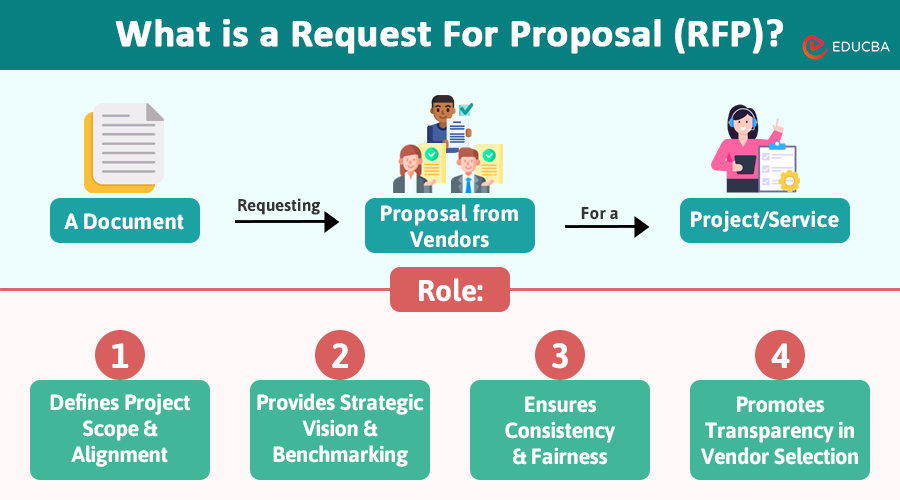
What is a Request for Proposal?
An RFP (Request for Proposal) is an organization’s document asking other businesses or vendors to submit their ideas or proposals for a specific project or service. It includes details about what the company needs, what they expect from the proposals, and how they will choose the winning bid. RFPs are a way for businesses to find the best option for a project by inviting different parties to compete with their offers. In this article, we will see why a well-crafted Request for Proposal is vital for ensuring successful project outcomes.
Role of Request for Proposal
The role of a Request for Proposal is:
1. Defines Project Scope and Alignment
A good Request for Proposal clearly defines the project’s scope, goals, and constraints. This helps vendors understand exactly what is needed and reduces the chance of misunderstandings. When everyone starts with the same information, comparing business proposals is easier.
2. Provides Strategic Vision and Benchmarking
A Request for Proposal is not just a proposal request but a strategic tool. It allows organizations to share their vision and set clear benchmarks for the project. This attracts vendors who can meet these standards, improving the quality of the proposals. Using RFP Automation software during this process helps streamline tasks, reduce manual errors, and maintain consistency across submissions.
3. Ensures Consistency and Fairness
A Request for Proposal ensures a fair evaluation process by providing the same information to all vendors. This consistency makes it simpler to compare responses and choose the best one.
4. Promotes Transparency in Vendor Selection
The RFP meaning business, assesses each vendor’s capabilities and competencies. The Request for Proposal allows for a thorough comparison by outlining specific criteria and requirements, ensuring that the chosen vendor is well-suited for the project.
Key Elements of an Effective Request for Proposal
Here are the key elements to include in a Request for Proposal:
1. Introduction: Begin with an overview of the RFP’s purpose and provide background on your organization.
2. Project Description: Give a detailed project outline, including its goals, scope, and what you expect as the final result.
3. Timeline: Specify important deadlines and project timelines so vendors know how quickly they need to respond and deliver.
4. Submission Guidelines: Offer clear instructions on how vendors should submit their proposals to ensure they are easy to review.
5. Selection Criteria: Clearly outline the selection criteria in the Request for Proposal. Vendors must understand how you assess their proposals and the key factors influencing your decision-making process. Also, specify any mandatory requirements that could lead to disqualification.
Need for Balancing Clarity and Flexibility in Request for Proposal
An RFP should be clear enough to outline the project’s requirements and flexible enough to allow vendors to suggest creative and cost-effective solutions. If the RFP is too strict, it might limit the vendors’ ability to offer innovative ideas that could benefit the organization.
While it is important to include certain non-negotiable standards, a Request for Proposal should also encourage vendors to use their expertise and propose unique solutions.
Additionally, clarity in an RFP should extend to the response format. Providing a clear format helps vendors focus on the content of their proposals rather than how to present them. However, there should still be space for vendors to highlight their strengths and what makes them stand out.
Strategies for Evaluating and Selecting the Best Proposal from RFP Responses
Here are some strategies to help you in the evaluation and selection process:
1. Develop a Scoring System
Establish a scoring system using the criteria specified in the Request for Proposal. Assign weights to different factors, such as cost, technical expertise, and project approach, to help objectively compare proposals.
2. Assemble a Diverse Evaluation Team
Form a team with members from different departments or areas of expertise. This ensures a well-rounded assessment of each proposal, covering technical, financial, and operational perspectives.
3. Conduct Thorough Review Sessions
Hold detailed review sessions in which the evaluation team discusses each proposal’s strengths and weaknesses. Analyzing each vendor’s approach can inform the selection process and identify potential areas for negotiation.
4. Use a Transparent Evaluation Process
Ensure that the evaluation process is transparent and consistent. Document how each proposal meets the Request for Proposal criteria and explain how you make the final decision. This helps maintain fairness and accountability.
5. Consider Vendor Interviews
If needed, invite top vendors for interviews or presentations. This will let you ask questions, clarify details, and assess the vendor’s understanding and enthusiasm for the project.
Final Thoughts
A well-crafted Request for Proposal is essential for successful project outcomes. It lays a solid foundation for selecting the right vendor, ensuring clear communication, and achieving project goals. Mastering the art of creating and evaluating RFPs is a key skill for any organization aiming for project success.
Recommended Articles
We hope this guide to creating and evaluating Requests for Proposal helps streamline your selection process and achieve successful project outcomes. Check out these additional articles for further insights on effective project management and vendor selection strategies.
